sensor TOYOTA RAV4 2006 Service Repair Manual
[x] Cancel search | Manufacturer: TOYOTA, Model Year: 2006, Model line: RAV4, Model: TOYOTA RAV4 2006Pages: 2000, PDF Size: 45.84 MB
Page 1538 of 2000
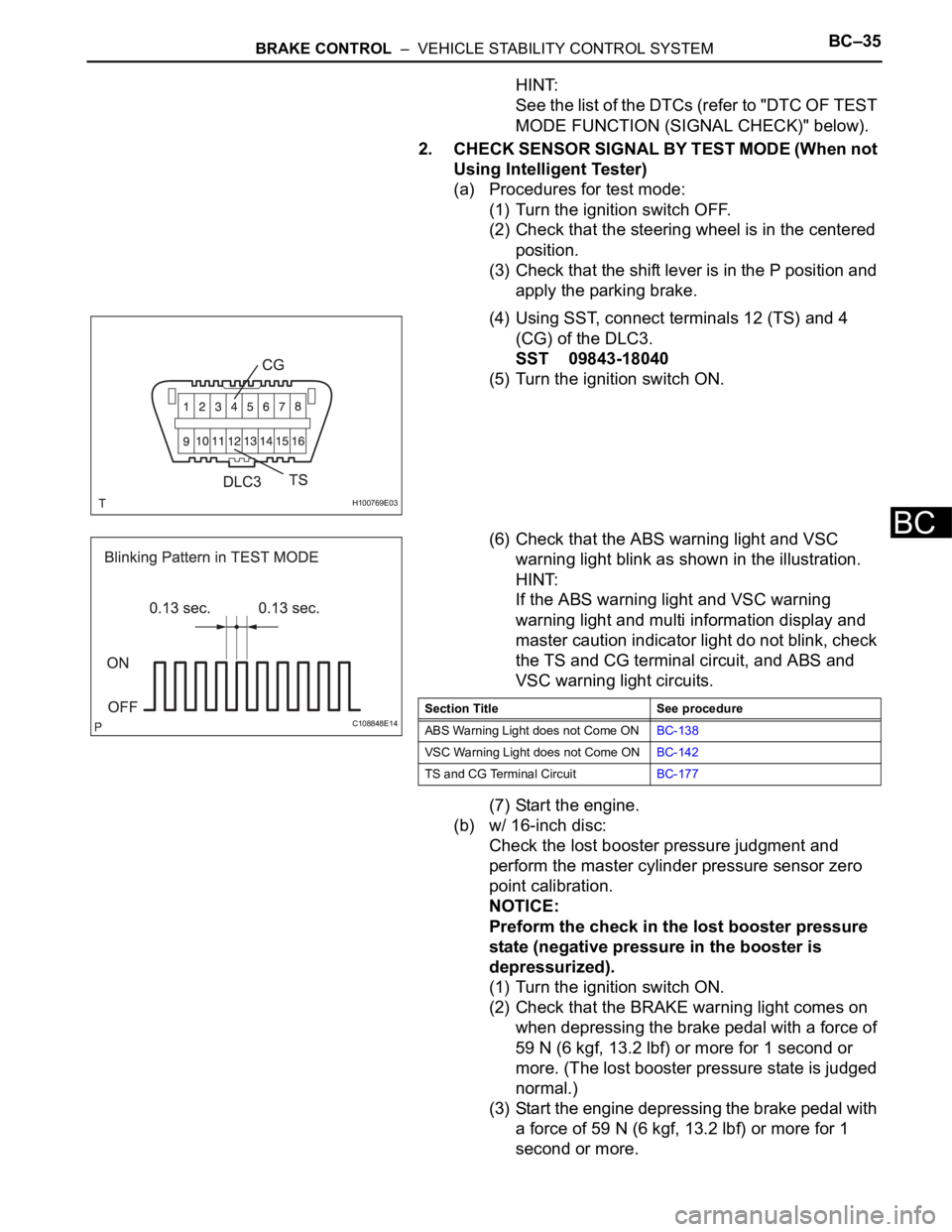
BRAKE CONTROL – VEHICLE STABILITY CONTROL SYSTEMBC–35
BC
HINT:
See the list of the DTCs (refer to "DTC OF TEST
MODE FUNCTION (SIGNAL CHECK)" below).
2. CHECK SENSOR SIGNAL BY TEST MODE (When not
Using Intelligent Tester)
(a) Procedures for test mode:
(1) Turn the ignition switch OFF.
(2) Check that the steering wheel is in the centered
position.
(3) Check that the shift lever is in the P position and
apply the parking brake.
(4) Using SST, connect terminals 12 (TS) and 4
(CG) of the DLC3.
SST 09843-18040
(5) Turn the ignition switch ON.
(6) Check that the ABS warning light and VSC
warning light blink as shown in the illustration.
HINT:
If the ABS warning light and VSC warning
warning light and multi information display and
master caution indicator light do not blink, check
the TS and CG terminal circuit, and ABS and
VSC warning light circuits.
(7) Start the engine.
(b) w/ 16-inch disc:
Check the lost booster pressure judgment and
perform the master cylinder pressure sensor zero
point calibration.
NOTICE:
Preform the check in the lost booster pressure
state (negative pressure in the booster is
depressurized).
(1) Turn the ignition switch ON.
(2) Check that the BRAKE warning light comes on
when depressing the brake pedal with a force of
59 N (6 kgf, 13.2 lbf) or more for 1 second or
more. (The lost booster pressure state is judged
normal.)
(3) Start the engine depressing the brake pedal with
a force of 59 N (6 kgf, 13.2 lbf) or more for 1
second or more.
H100769E03
C108848E14Section Title See procedure
ABS Warning Light does not Come ONBC-138
VSC Warning Light does not Come ONBC-142
TS and CG Terminal CircuitBC-177
Page 1539 of 2000

BC–36BRAKE CONTROL – VEHICLE STABILITY CONTROL SYSTEM
BC
(4) Check that the brake warning light goes off when
quickly releasing the brake pedal. (The lost
booster pressure state is judged normal.)
(5) Leave the vehicle for 1 second or more. (Master
cylinder pressure sensor zero point calibration.)
NOTICE:
• If you slowly depress the brake pedal or
depress it again, master cylinder pressure
sensor zero point calibration is not
performed normally.
• If the lost booster pressure judgment
check is not completed normally, the
master cylinder pressure sensor check is
not judged.
• If a recheck is performed after the engine
has started, end the Test Mode, enter Test
Mode again, and release the vacuum in
the booster by pumping the brake pedal
prior to the recheck.
(c) Check the deceleration sensor.
(1) Keep the vehicle stationary on a level surface for
1 second or more.
HINT:
The deceleration sensor check can be
performed together with the following master
cylinder pressure sensor check.
(d) Check the master cylinder pressure sensor.
(1) Leave the vehicle in a stationary condition and
release the brake pedal for 1 second or more,
and quickly depress the brake pedal with a force
of 98 N (10 kgf, 22 lbf) or more for 1 second.
Check that the ABS warning light remains
illuminated for 3 seconds.
HINT:
• Ensure that the ABS warning light comes on.
• While the ABS warning light remains
illuminated, continue depressing the brake
pedal with a force of 98 N (10 kgf, 22 lbf) or
more.
• The ABS warning light comes on for 3
seconds every time the brake pedal operation
above is performed.
(e) Check the speed sensor.
(1) Check that the ABS warning light is blinking as
shown in the illustration.
(2) Check the speed sensor signal.
1. Drive the vehicle straight forward at a speed
of 45 km/h (28 mph) or more for several
seconds.
C108848E01
Page 1540 of 2000

BRAKE CONTROL – VEHICLE STABILITY CONTROL SYSTEMBC–37
BC
2. Check that the ABS warning light goes off.
NOTICE:
• The speed sensor check may not be
completed if the sensor check is
started with the steering wheel turned
or one or more wheels spinning.
• If the speed sensor check is
commenced while the steering wheel is
turned, the ABS warning light may
come on after the low speed check is
finished.
• The ABS warning light comes on
immediately when an abnormality is
detected.
• When the speed sensor signal is
normal, the ABS warning light goes off
while driving at 45 km/h (28 mph) or
more, and blinks in the test mode
pattern while the vehicle is stationary.
• Do not drive the vehicle at a speed of 80
km/h (50 mph) or more after the ABS
warning light turns off, because test
mode DTCs are set again when the
vehicle speed exceeds 80 km/h (50
mph).
3. Stop the vehicle.
C115115E04
Page 1541 of 2000
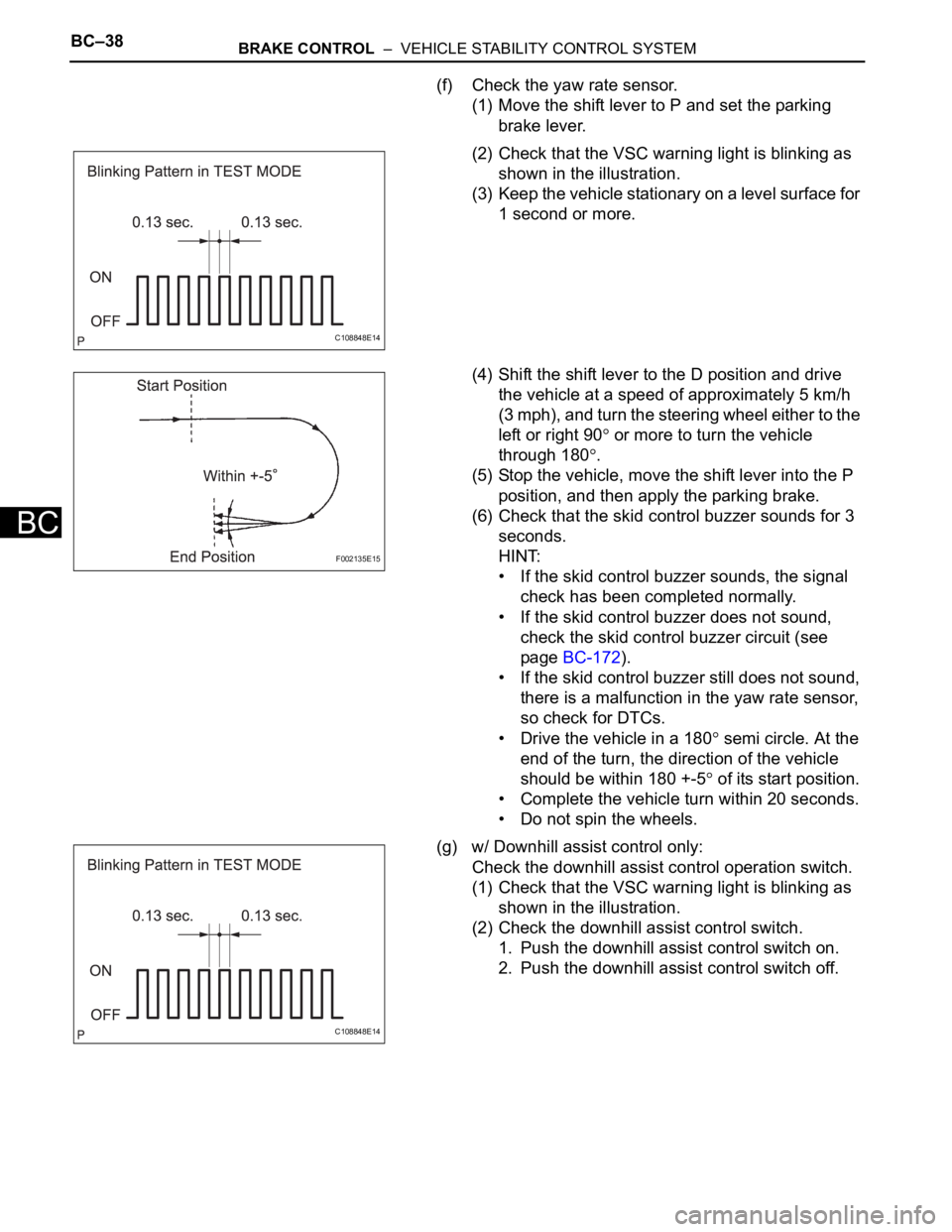
BC–38BRAKE CONTROL – VEHICLE STABILITY CONTROL SYSTEM
BC
(f) Check the yaw rate sensor.
(1) Move the shift lever to P and set the parking
brake lever.
(2) Check that the VSC warning light is blinking as
shown in the illustration.
(3) Keep the vehicle stationary on a level surface for
1 second or more.
(4) Shift the shift lever to the D position and drive
the vehicle at a speed of approximately 5 km/h
(3 mph), and turn the steering wheel either to the
left or right 90
or more to turn the vehicle
through 180
.
(5) Stop the vehicle, move the shift lever into the P
position, and then apply the parking brake.
(6) Check that the skid control buzzer sounds for 3
seconds.
HINT:
• If the skid control buzzer sounds, the signal
check has been completed normally.
• If the skid control buzzer does not sound,
check the skid control buzzer circuit (see
page BC-172).
• If the skid control buzzer still does not sound,
there is a malfunction in the yaw rate sensor,
so check for DTCs.
• Drive the vehicle in a 180
semi circle. At the
end of the turn, the direction of the vehicle
should be within 180 +-5
of its start position.
• Complete the vehicle turn within 20 seconds.
• Do not spin the wheels.
(g) w/ Downhill assist control only:
Check the downhill assist control operation switch.
(1) Check that the VSC warning light is blinking as
shown in the illustration.
(2) Check the downhill assist control switch.
1. Push the downhill assist control switch on.
2. Push the downhill assist control switch off.
C108848E14
F002135E15
C108848E14
Page 1542 of 2000
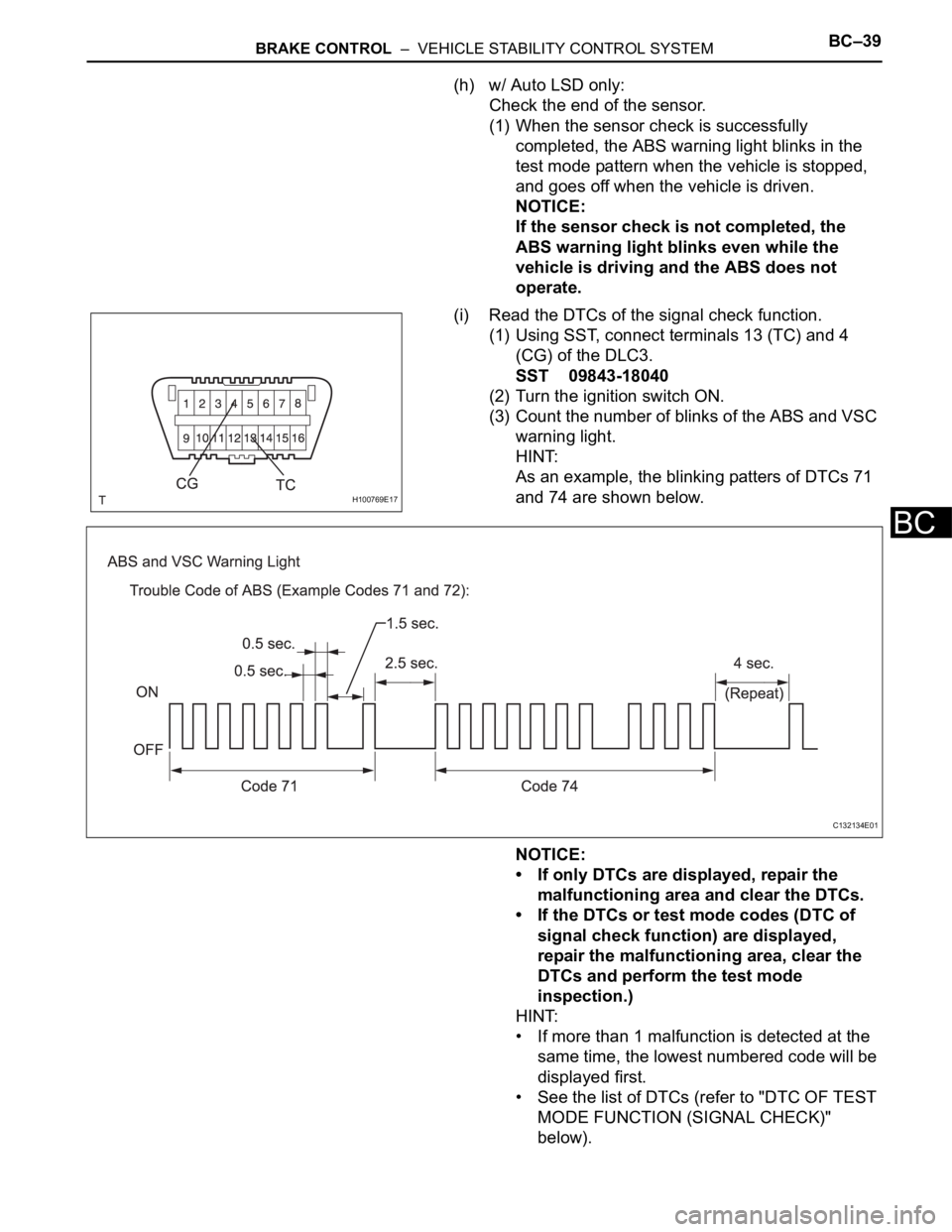
BRAKE CONTROL – VEHICLE STABILITY CONTROL SYSTEMBC–39
BC
(h) w/ Auto LSD only:
Check the end of the sensor.
(1) When the sensor check is successfully
completed, the ABS warning light blinks in the
test mode pattern when the vehicle is stopped,
and goes off when the vehicle is driven.
NOTICE:
If the sensor check is not completed, the
ABS warning light blinks even while the
vehicle is driving and the ABS does not
operate.
(i) Read the DTCs of the signal check function.
(1) Using SST, connect terminals 13 (TC) and 4
(CG) of the DLC3.
SST 09843-18040
(2) Turn the ignition switch ON.
(3) Count the number of blinks of the ABS and VSC
warning light.
HINT:
As an example, the blinking patters of DTCs 71
and 74 are shown below.
NOTICE:
• If only DTCs are displayed, repair the
malfunctioning area and clear the DTCs.
• If the DTCs or test mode codes (DTC of
signal check function) are displayed,
repair the malfunctioning area, clear the
DTCs and perform the test mode
inspection.)
HINT:
• If more than 1 malfunction is detected at the
same time, the lowest numbered code will be
displayed first.
• See the list of DTCs (refer to "DTC OF TEST
MODE FUNCTION (SIGNAL CHECK)"
below).
H100769E17
C132134E01
Page 1543 of 2000

BC–40BRAKE CONTROL – VEHICLE STABILITY CONTROL SYSTEM
BC
• If all sensors are normal, a normal system
code is output (the light comes on for 0.25
seconds at intervals of 0.25 seconds).
(4) After the check, disconnect SST from terminals
13 (TC) and 4 (CG) of the DLC3.
(5) Turn the ignition switch OFF.
3. DTC OF TEST MODE FUNCTION (SIGNAL CHECK)
DTC of ABS sensor check function:
DTC of VSC sensor check function:
HINT:
• *: w/ Downhill assist control
• The DTCs in this table are only output in Test Mode.
• The detection of DTCs from C1271/71 to C1274/74 is
completed before the vehicle speed reaches 5 km/h
(3 mph).
• The detection of DTCs from C1275/75 to C1278/78 is
completed before the vehicle speed reaches 45 km/h
(28 mph).
DTC No. Diagnosis Trouble Areas
C1271/71 Low output signal of front speed sensor RH • Front speed sensor RH
• Speed sensor circuit
• Sensor installation
C1272/72 Low output signal of front speed sensor LH • Front speed sensor LH
• Speed sensor circuit
• Sensor installation
C1273/73 Low output signal of rear speed sensor RH • Rear speed sensor RH (for 4WD)
• Skid control sensor RH (for 2WD)
• Speed sensor circuit
• Sensor installation
C1274/74 Low output signal of rear speed sensor LH • Rear speed sensor LH (4WD)
• Skid control sensor LH (2WD)
• Speed sensor circuit
• Sensor installation
C1275/75 Abnormal change in output signal of front
speed sensor RH• Sensor installation
• Speed sensor rotor
• Foreign matter on sensor tip or sensor
rotor
C1276/76 Abnormal change in output signal of front
speed sensor LH• Sensor installation
• Speed sensor rotor
• Foreign matter on sensor tip or sensor
rotor
C1277/77 Abnormal change in output signal of rear
speed sensor RH• Sensor installation
• Speed sensor rotor
• Foreign matter on sensor tip or sensor
rotor
C1278/78 Abnormal change in output signal of rear
speed sensor LH• Sensor installation
• Speed sensor rotor
• Foreign matter on sensor tip or sensor
rotor
C1279/79 Deceleration sensor output voltage
malfunction• Yaw rate sensor
• Sensor installation
C1281/81 Master cylinder pressure sensor output
malfunction• Master cylinder pressure sensor
• Brake pedal load sensing switch (w/ 16-
inch disc)
DTC No. Diagnosis Trouble Areas
C0371/71 Yaw rate sensor Yaw rate sensor
C1379/74* Downhill assist control operation switch Downhill assist control switch
Page 1544 of 2000
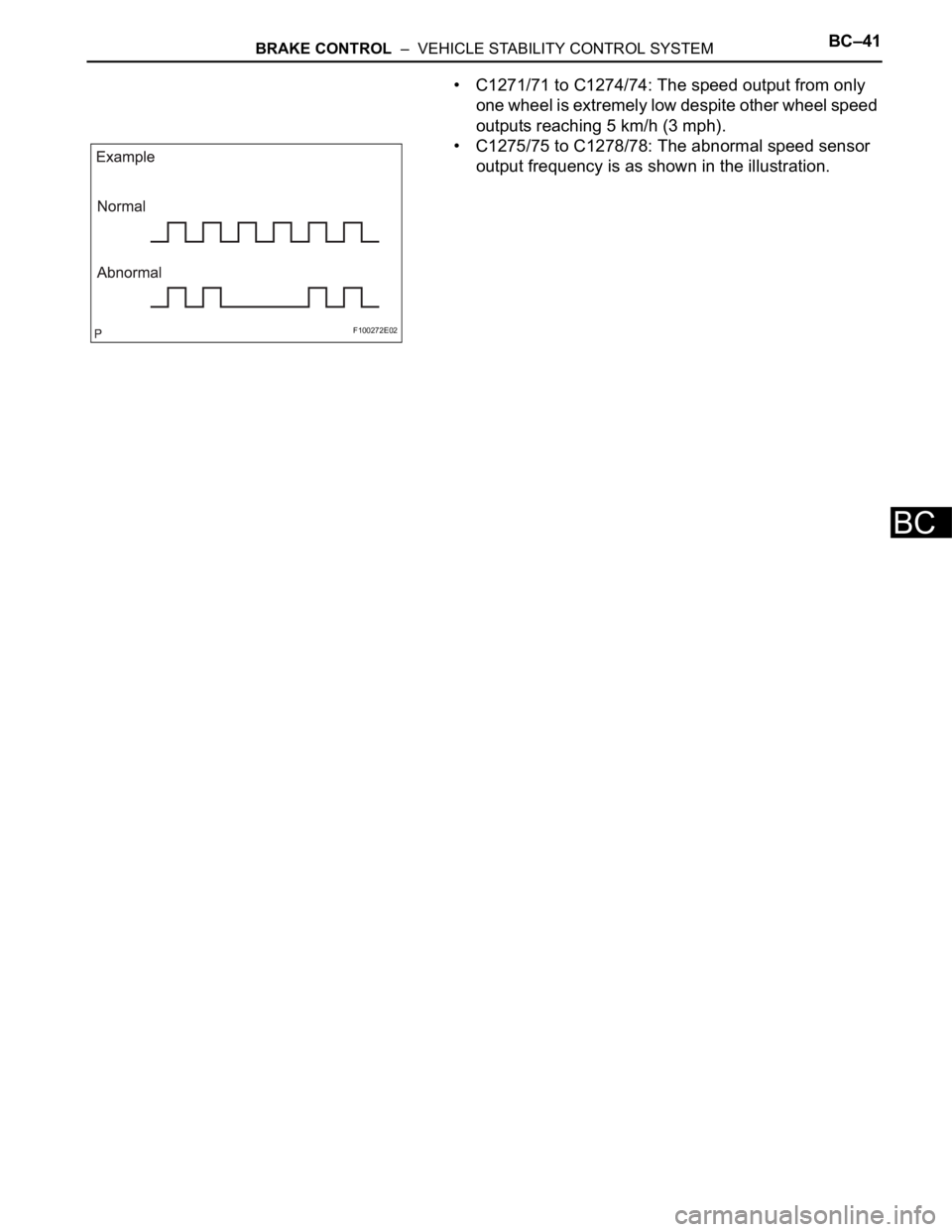
BRAKE CONTROL – VEHICLE STABILITY CONTROL SYSTEMBC–41
BC
• C1271/71 to C1274/74: The speed output from only
one wheel is extremely low despite other wheel speed
outputs reaching 5 km/h (3 mph).
• C1275/75 to C1278/78: The abnormal speed sensor
output frequency is as shown in the illustration.
F100272E02
Page 1545 of 2000
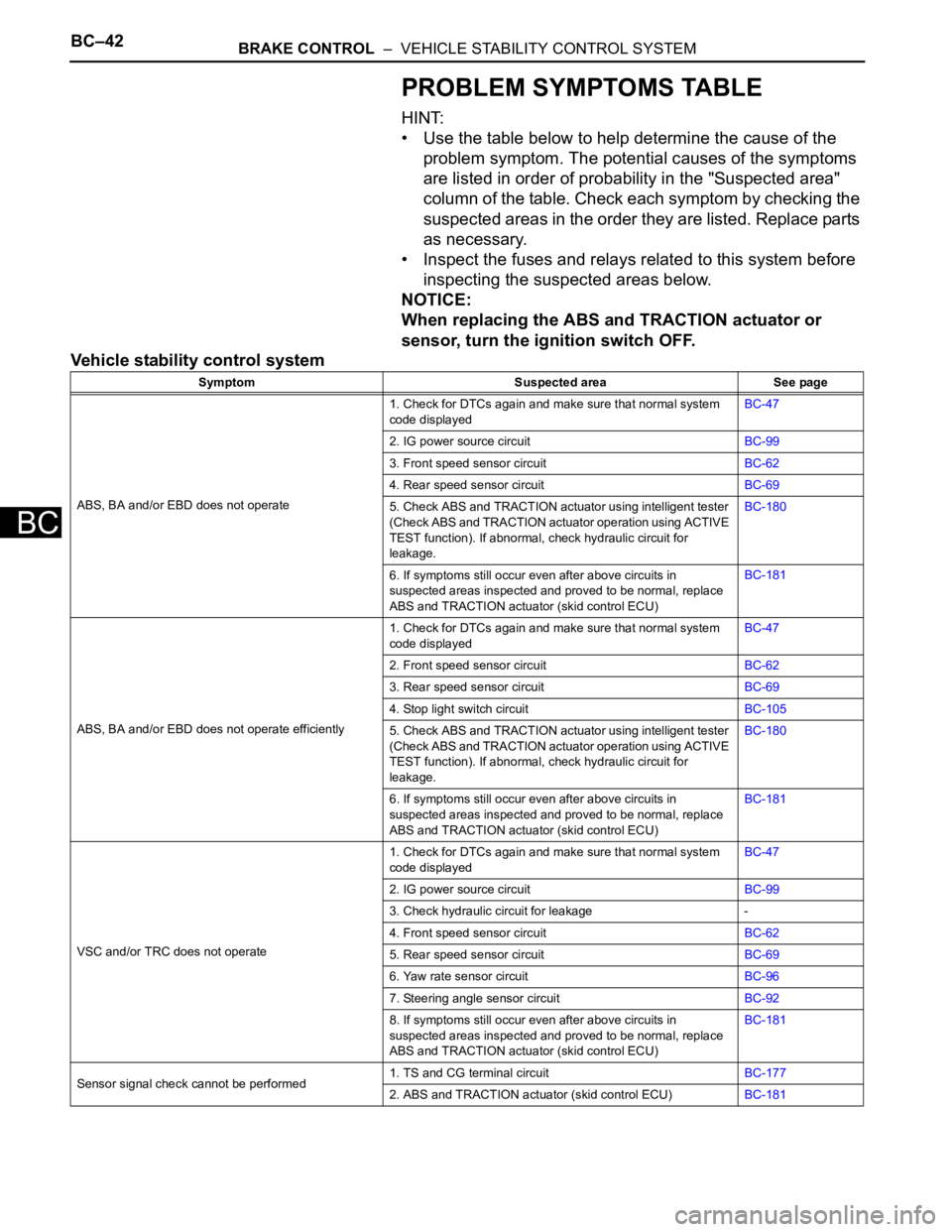
BC–42BRAKE CONTROL – VEHICLE STABILITY CONTROL SYSTEM
BC
PROBLEM SYMPTOMS TABLE
HINT:
• Use the table below to help determine the cause of the
problem symptom. The potential causes of the symptoms
are listed in order of probability in the "Suspected area"
column of the table. Check each symptom by checking the
suspected areas in the order they are listed. Replace parts
as necessary.
• Inspect the fuses and relays related to this system before
inspecting the suspected areas below.
NOTICE:
When replacing the ABS and TRACTION actuator or
sensor, turn the ignition switch OFF.
Vehicle stability control system
Symptom Suspected area See page
ABS, BA and/or EBD does not operate1. Check for DTCs again and make sure that normal system
code displayedBC-47
2. IG power source circuitBC-99
3. Front speed sensor circuitBC-62
4. Rear speed sensor circuitBC-69
5. Check ABS and TRACTION actuator using intelligent tester
(Check ABS and TRACTION actuator operation using ACTIVE
TEST function). If abnormal, check hydraulic circuit for
leakage.BC-180
6. If symptoms still occur even after above circuits in
suspected areas inspected and proved to be normal, replace
ABS and TRACTION actuator (skid control ECU)BC-181
ABS, BA and/or EBD does not operate efficiently1. Check for DTCs again and make sure that normal system
code displayedBC-47
2. Front speed sensor circuitBC-62
3. Rear speed sensor circuitBC-69
4. Stop light switch circuitBC-105
5. Check ABS and TRACTION actuator using intelligent tester
(Check ABS and TRACTION actuator operation using ACTIVE
TEST function). If abnormal, check hydraulic circuit for
leakage.BC-180
6. If symptoms still occur even after above circuits in
suspected areas inspected and proved to be normal, replace
ABS and TRACTION actuator (skid control ECU)BC-181
VSC and/or TRC does not operate1. Check for DTCs again and make sure that normal system
code displayedBC-47
2. IG power source circuitBC-99
3. Check hydraulic circuit for leakage -
4. Front speed sensor circuitBC-62
5. Rear speed sensor circuitBC-69
6. Yaw rate sensor circuitBC-96
7. Steering angle sensor circuitBC-92
8. If symptoms still occur even after above circuits in
suspected areas inspected and proved to be normal, replace
ABS and TRACTION actuator (skid control ECU)BC-181
Sensor signal check cannot be performed1. TS and CG terminal circuitBC-177
2. ABS and TRACTION actuator (skid control ECU)BC-181
Page 1547 of 2000
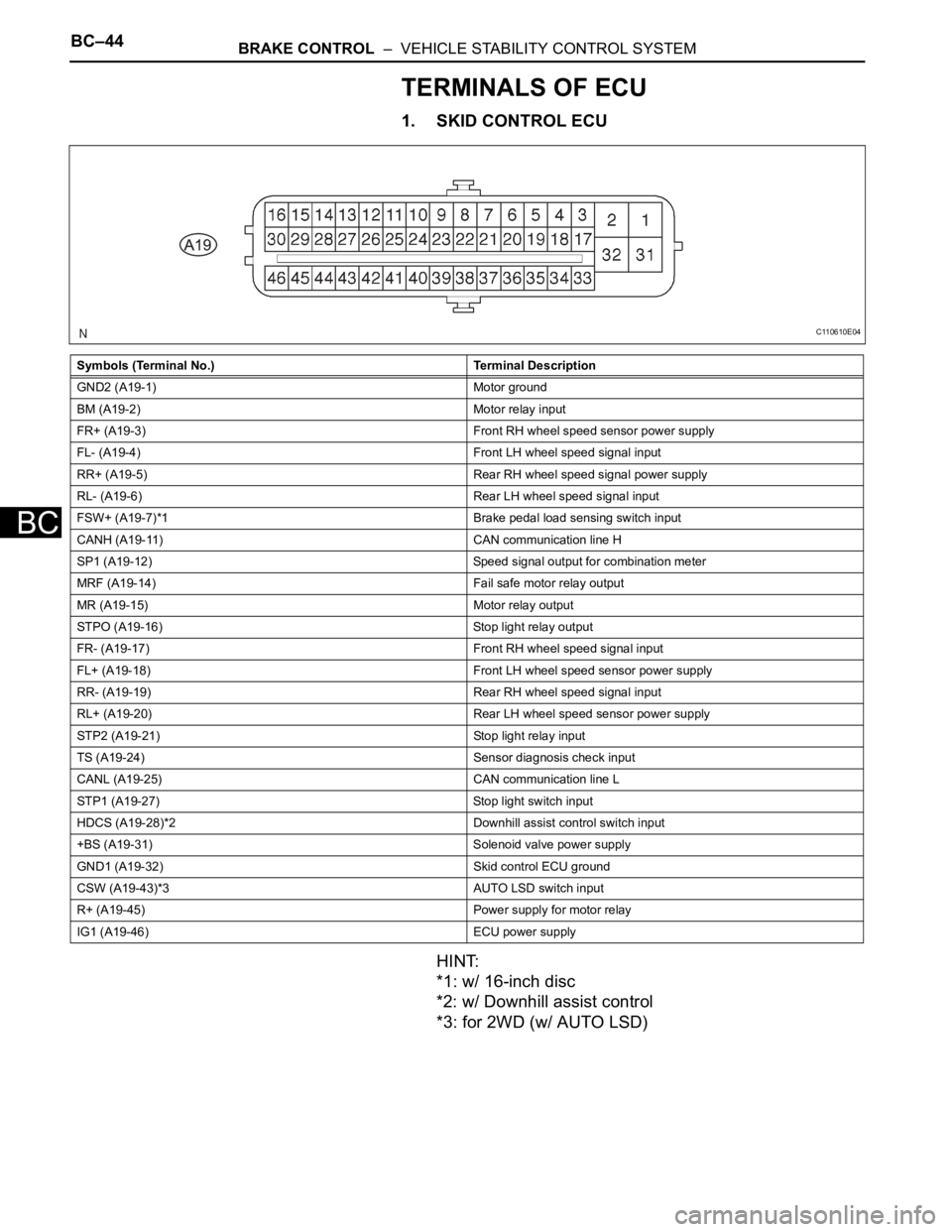
BC–44BRAKE CONTROL – VEHICLE STABILITY CONTROL SYSTEM
BC
TERMINALS OF ECU
1. SKID CONTROL ECU
HINT:
*1: w/ 16-inch disc
*2: w/ Downhill assist control
*3: for 2WD (w/ AUTO LSD)
Symbols (Terminal No.) Terminal Description
GND2 (A19-1) Motor ground
BM (A19-2) Motor relay input
FR+ (A19-3) Front RH wheel speed sensor power supply
FL- (A19-4) Front LH wheel speed signal input
RR+ (A19-5) Rear RH wheel speed signal power supply
RL- (A19-6) Rear LH wheel speed signal input
FSW+ (A19-7)*1 Brake pedal load sensing switch input
CANH (A19-11) CAN communication line H
SP1 (A19-12) Speed signal output for combination meter
MRF (A19-14) Fail safe motor relay output
MR (A19-15) Motor relay output
STPO (A19-16) Stop light relay output
FR- (A19-17) Front RH wheel speed signal input
FL+ (A19-18) Front LH wheel speed sensor power supply
RR- (A19-19) Rear RH wheel speed signal input
RL+ (A19-20) Rear LH wheel speed sensor power supply
STP2 (A19-21) Stop light relay input
TS (A19-24) Sensor diagnosis check input
CANL (A19-25) CAN communication line L
STP1 (A19-27) Stop light switch input
HDCS (A19-28)*2 Downhill assist control switch input
+BS (A19-31) Solenoid valve power supply
GND1 (A19-32) Skid control ECU ground
CSW (A19-43)*3 AUTO LSD switch input
R+ (A19-45) Power supply for motor relay
IG1 (A19-46) ECU power supply
C110610E04
Page 1552 of 2000
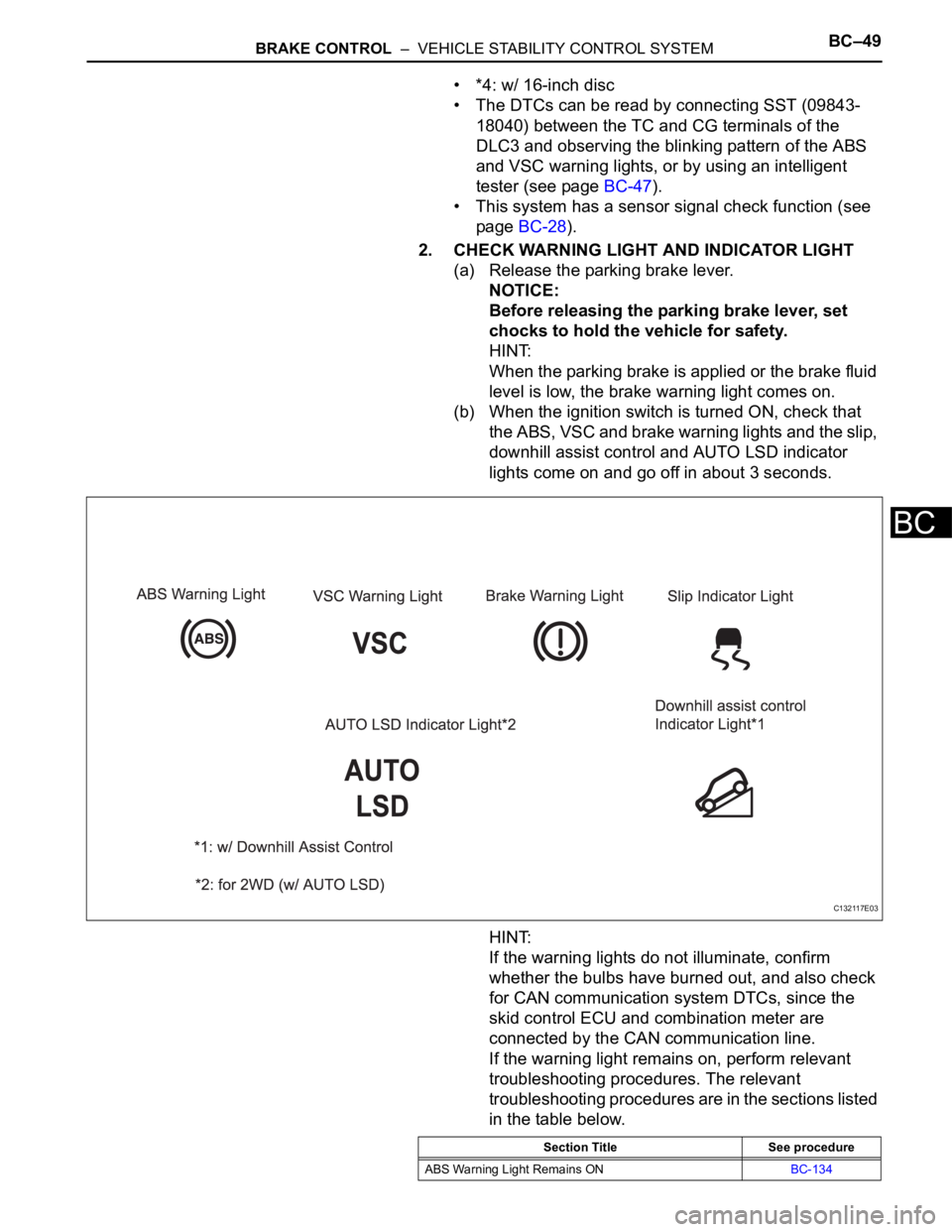
BRAKE CONTROL – VEHICLE STABILITY CONTROL SYSTEMBC–49
BC
• *4: w/ 16-inch disc
• The DTCs can be read by connecting SST (09843-
18040) between the TC and CG terminals of the
DLC3 and observing the blinking pattern of the ABS
and VSC warning lights, or by using an intelligent
tester (see page BC-47).
• This system has a sensor signal check function (see
page BC-28).
2. CHECK WARNING LIGHT AND INDICATOR LIGHT
(a) Release the parking brake lever.
NOTICE:
Before releasing the parking brake lever, set
chocks to hold the vehicle for safety.
HINT:
When the parking brake is applied or the brake fluid
level is low, the brake warning light comes on.
(b) When the ignition switch is turned ON, check that
the ABS, VSC and brake warning lights and the slip,
downhill assist control and AUTO LSD indicator
lights come on and go off in about 3 seconds.
HINT:
If the warning lights do not illuminate, confirm
whether the bulbs have burned out, and also check
for CAN communication system DTCs, since the
skid control ECU and combination meter are
connected by the CAN communication line.
If the warning light remains on, perform relevant
troubleshooting procedures. The relevant
troubleshooting procedures are in the sections listed
in the table below.
C132117E03
Section Title See procedure
ABS Warning Light Remains ONBC-134